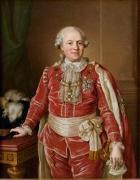China al por mayor de Marco de Oleo |
|||||||||||

|
|||||||||||
|
|
|
||||||||||||||
|
Ulrika Pasch
(10 July 1735 - 2 April 1796), also known as Ulla Pasch, was a Swedish painter and miniaturist. She was one of few female artists known in Scandinavia before the 19th century. She was a member of the Royal Swedish Academy of Arts (1773). Ulrika Pasch was born in an artistic family, daughter of the painter Lorens Pasch the Elder, and sister of the future painter Lorens Pasch the Younger. Her uncle, Johan Pasch, was also a painter. In the 1750s, when her brother was studying art abroad, her father's career declined severely, and Ulrika was forced to become a housekeeper in the home of her maternal aunt's widower. Her uncle however allowed her to spend a lot of time developing her artistic talent, and from 1756, she had become a professional portrait painter and was able to support her father and her sister in this way. After her father's death, she lived with her sister and set up her own studio. When her brother returned to Sweden in 1766, she had been a professional artist for ten years and her clientele had moved from the middle class to the upper classes and the aristocracy. Ulrika Pasch and her brother then worked together as professional artists, shared their studio and guided each other in their work; their collaboration was one of mutual respect and harmony, and she is known to have helped him painting the textiles and costumes, a work he found tiring. Their baby-sister Helena Sofia (1744-96) took care of their household; she is described as somewhat talented in art as well, but she spent her life as her siblings "dutiful" house-keeper, and is said to have been deeply devoted to especially Ulrika. |
||||||||||||||
|
|
||||||||||||||
|
||||||||||||||
|
|
||||||||||||||
| Ulrika Pasch
(10 July 1735 - 2 April 1796), also known as Ulla Pasch, was a Swedish painter and miniaturist. She was one of few female artists known in Scandinavia before the 19th century. She was a member of the Royal Swedish Academy of Arts (1773). Ulrika Pasch was born in an artistic family, daughter of the painter Lorens Pasch the Elder, and sister of the future painter Lorens Pasch the Younger. Her uncle, Johan Pasch, was also a painter. In the 1750s, when her brother was studying art abroad, her father's career declined severely, and Ulrika was forced to become a housekeeper in the home of her maternal aunt's widower. Her uncle however allowed her to spend a lot of time developing her artistic talent, and from 1756, she had become a professional portrait painter and was able to support her father and her sister in this way. After her father's death, she lived with her sister and set up her own studio. When her brother returned to Sweden in 1766, she had been a professional artist for ten years and her clientele had moved from the middle class to the upper classes and the aristocracy. Ulrika Pasch and her brother then worked together as professional artists, shared their studio and guided each other in their work; their collaboration was one of mutual respect and harmony, and she is known to have helped him painting the textiles and costumes, a work he found tiring. Their baby-sister Helena Sofia (1744-96) took care of their household; she is described as somewhat talented in art as well, but she spent her life as her siblings "dutiful" house-keeper, and is said to have been deeply devoted to especially Ulrika. Date 18th century Medium Oil on canvas cjr |
||||||||||||||
|
Related Paintings to Ulrika Pasch :. |
||||||||||||||
|
|
||||||||||||||
|
|
||||||||||||||
|
CONTACTE EEUU |







